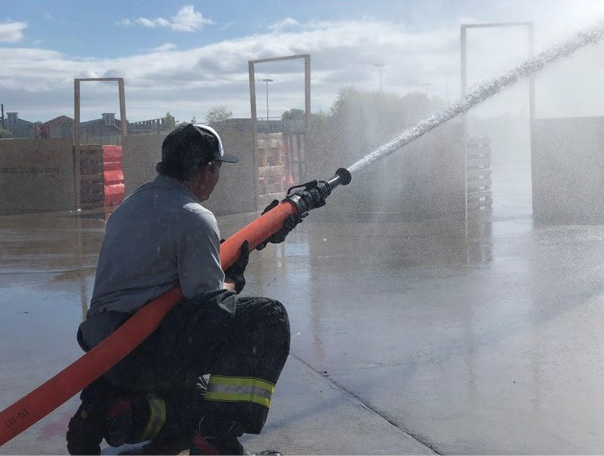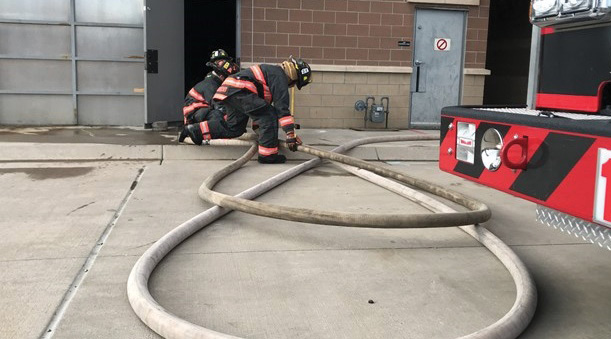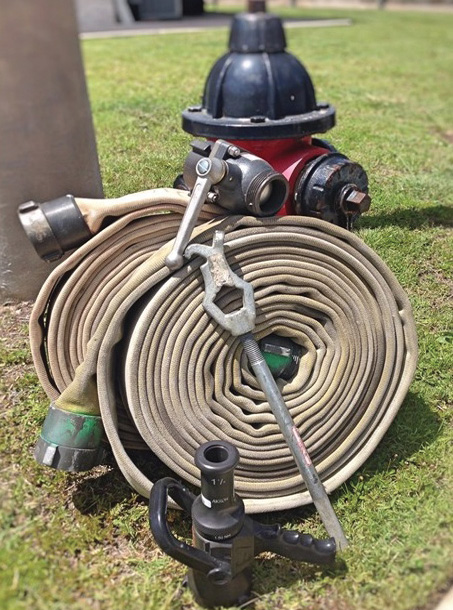
TRAINING NOTEBOOK ❘ By JONATHAN BRUMLEY
If your experience is anything like mine, you will have noticed that many engine companies rarely attempt to deploy a 2½-inch line. The 2½-inch line has been relegated to the sidelines, seeing action only after a fire has long since been declared defensive. Some departments have even opted to remove this line from their service completely, leaving only small-diameter hose in their arsenal of handlines.
RELATED TRAINING
Systematic Views of the 2 1/2-Inch Handline in Fire Attack
Off-the-Beaten-Path Engine Company Tips
Although departments push further into the usage of 150- to 200-foot crosslays with 1¾-inch handlines, they do so at the cost of basic skills such as estimating stretches and proper hoseline selection. True, the crosslay is generally more than capable of handling the typical one- or two-room fire in a residence, but you cannot assume that it is the right line for all fires. As simple as that sounds, it is difficult to put into practice on the fireground when departments do not practice and use other fire attack options. This leaves a tremendous gap between attacking fires with a small-diameter handline and initiating defensive operations. You must fill that gap by having a large attack line available.

(1) With proper technique, a single firefighter is capable of deploying and operating a medium-diameter handline. (Photo by Shawn Duncan.)

(2) A ground-based hose handling position will increase the duration in which a nozzle firefighter is able to flow water. Allowing more of the hoseline to contact the ground will allow its weight and friction to aid in countering nozzle reaction. (Photo by author.)
Deploying a 2½-inch line has become countercultural for many in the fire service. Those who consider deploying a medium-diameter handline are often thought to be either crazy for trying or stupid for attempting what “is only possible with the staffing levels of urban departments.” Why would deploying one of the most basic, time-tested pieces of equipment on the engine be considered so taboo? The answer often lies within past deployment failures or a misunderstanding of how to best capitalize on the usage of a 2½-inch line.
Admittedly, I failed to understand how to efficiently use a 2½-inch line for much of my early career. I was offered general instruction in training, but I was not initially made to understand the intricacies needed for successful deployment of this line. Instead, we treated the line as though we would pull it only during “worst-case scenarios.” Training was limited to discussing how difficult it would be to deploy. We almost always fell short of putting our hands on the line and flowing water. Simply put, my failure to move beyond tailboard discussions let me down.
Self-Training
I sat at the computer during one slow afternoon at the firehouse and watched fire training videos. One video in particular caught my attention: A single firefighter was able to flow water and advance a 2½-inch handline without assistance. It would have been easy to write the video off as impossible, just some charade pulled off behind the camera lens. After all, my experience with a similar line included multiple firefighters standing bunched up at the nozzle, doing everything they could to fight the massive amount of nozzle reaction. I knew I was not capable of replicating what had been accomplished in the video with my understanding of a 2½-inch operation. This was a moment of epiphany. My view of pulling a medium-diameter handline needed to change if I was to ever perform at the level witnessed in that short clip.
This newfound desire to effectively use the 2½-inch line on my engine led me through what can be described only as a years-long educational rabbit hole. The works of and hands-on instruction by industry leaders such as Dennis LeGear, Dave McGrail, Dave Fornell, Brian Brush, and the Nozzle Forward cadre flipped my perspective on what an engine company can do with a 2½-inch handline. Similar to finding missing puzzle pieces, I saw the big picture—that what was performed in the video was not only possible but could be universally applied in any fire department. I found that three key components need to be addressed for successful deployments: staffing, maneuverability, and competency.
Staffing
Perhaps the biggest argument against deploying a 2½-inch handline is the notion that we must commit a large number of personnel to a single line. This is evidenced by the number of instructors who still teach that flowing a 2½-inch must be handled in one of two ways: stack up three or more firefighters at the nozzle or loop and then sit on the line. Factoring in the need to advance the line or navigate obstructions leaves this type of instruction without answers.
Certainly, there are circumstances that require multiple companies to move a 2½-inch line effectively through a structure. They include long stretches, stretching around a large number of corners/doorways, and stretches in stairwells. That said, it is incorrect to assume that as many as six people are needed for every 2½-inch handline deployment. In reality, in the vast majority of fires to which we respond, the seat of the fire is within 100 feet of an immediately dangerous to life or health environment; from that point, we can reach the seat in three or fewer corners. Even if a single firefighter is at the nozzle and another is committed to manipulating hose around obstacles, accomplishing a knockdown on these types of fires is possible with limited staffing.
Further, there is a direct correlation between the number of personnel required on a handline and the nozzle reaction encountered while flowing. High-pressure fog nozzles have almost single-handedly created the culture of fear that surrounds a 2½-inch handline. A 2½-inch handline flowing 300 gallons per minute (gpm) with a fog nozzle requiring 100 pounds per square inch (psi) of tip pressure exerts more than 150 pounds of force on the firefighter operating the line. It is unacceptable to expect any firefighter to handle that much nozzle reaction.
Late Fire Department of New York (FDNY) Lieutenant Andy Fredericks believed that a nozzle reaction of 60 to 70 psi was ideal for a single firefighter.1 With the disparity between the 70-psi benchmark and the high-pressure fog nozzle’s reaction force being more than double that, it is no wonder that personnel struggle for control. The true solution to this problem is to change nozzles to smooth bore or a low-pressure, fixed gallonage fog option. Flowing the same 300 gpm out of a nozzle with a 50-psi tip pressure will reduce the reaction force to around 100 psi. Although this is at the upper limits of what one firefighter can manage, it is well within the abilities of two firefighters. A low-pressure nozzle is paramount to the success of using a large attack line.
If the line is to remain stagnant for any time, keep it low to the ground. The same weight that makes the line difficult to move also assists in absorbing nozzle reaction because of the friction caused by the hose’s contacting the ground. The backup firefighter will pin the line to the ground using his body weight; this is far superior to standing with the hoseline. Also consider using corners or other stable objects to brace the line. Companies will benefit from using pull loops or bundled finishes to standard hoseloads. Not only does this clarify how much hose is being removed from the apparatus, but also it will provide for predetermined layouts once the objective has been reached. Each of these steps could potentially eliminate the need for additional personnel on the handline.
Maneuverability
Do not overlook the fundamentals of handling hoselines. Engine companies will struggle with 2½-inch handline deployment when they have the same expectations as they do of a smaller hoseline. Our ability to “muscle through” mistakes in line placement, body positioning, or grip on small-diameter attack lines cause many frustrations when members cannot accomplish the same on a 2½-inch handline.
Lay out the hose in a fashion that is advantageous to advancement prior to charging the line. Go through a mental checklist of how the hose has been deployed, whether you can eliminate any obstacles by moving the hose, and whether you need to tie off the hose while operating in elevated positions. Taking a little extra time to focus on the basics will pay dividends in the operation’s timeliness and the overall physical efforts required.
Departments must also consider every aspect of the hose they purchase, not just the cost. Jacket construction, susceptibility to kinking, and line weight are directly related to the hose and will impact how a line is manipulated during a stretch. Departments must ultimately determine what they expect from a hose and not rely on a manufacturer to decide for them; failing to do so could have unexpected results when deploying the hoselines on the fireground. Oakland (CA) Fire Department Captain (Ret.) Dennis LeGear has shown that the solution for creating lighter hose and lower friction loss values is to increase the internal diameter of the hose.2 Hose being marketed by all major manufacturers as 2½-inch has been shown to range in internal diameters from 2½- to 2.88-inch and greater. A hose with an internal diameter of 2½-inch will hold about 212 pounds (25.4 gallons) of water per 100 feet. However, a hose with an internal diameter of 2.88 inches will hold 281 pounds (nearly 70 more pounds!) in that same 100 feet of hose because of the additional 8.3-gallon capacity created by the size difference.
Consider for a moment that there are two ground ladder options on the market. I was previously assigned to a station with a tower ladder that carried a 35-foot extension ladder with three total sections and a gross weight of 170 pounds. Even with four-person staffing, firefighters were reluctant to deploy the ladder because of its weight. Another brand of 35-foot extension ladder with three sections, which is carried on my assigned ladder truck, weighs 129 pounds. A single firefighter deploys this ladder on many occasions. The approximate 40-pound difference between the two extension ladders was also the difference between whether or not the ladder was left on the back of the truck. If weight makes such a significant difference in ladders, it most definitely impacts hose operations as well. Simply put, producing a lightweight hose option with a low friction loss coefficient can cripple the firefighters who are supposed to benefit from the “improvements.” An engine company can greatly improve its ability to manipulate hose by evaluating its entire fire stream package in more ways than how it impacts the budget.

(3) Intentional efforts to lay out hose properly will lead to crew efficiencies and decrease overall fatigue. The sections of hose that will move first during an advance should never be underneath portions that will remain static. (Photo by Shawn Duncan.)

(4) Because of lower pressure demands in an attack system that uses 2½-inch hose, valuable training can take place with limited equipment and without a pumping apparatus. (Photo by author.)
Tactically speaking, it may be advantageous to initiate fire attack with a larger handline and then obtain full extinguishment with a smaller hoseline. This is especially helpful when starting fire attack from the exterior with the goal of moving interior. If you encounter a large body of fire on arrival, stretch a large attack line to achieve initial knockdown. Companies can then decide if it is best to switch to a line of greater maneuverability for hot spots and overhaul. Crews should be well versed in evolutions of stretching additional attack lines and removing the tip from the 2½-inch nozzle and then extending off that line with a smaller-diameter hoseline. In each of these scenarios, personnel benefit from a greater volume of water on arrival and an increased ability to move through obstacles.
Competency with Medium-Diameter Hoselines
Competency begins with understanding when to deploy a 2½-inch hoseline. The acronym ADULTS, popularized by the FDNY, has become the gold standard for defining when you should pull a large attack line. The acronym covers the six instances for 2½-inch deployments on the fireground, which are Advanced fire on arrival, Defensive operations, Unable to determine the size of the fire area, Large uncompartmentalized spaces, Tons of water, and Standpipe operations. Although you may not use 2½-inch hose exclusively in these six circumstances, they should serve as a guide for the company officer in confidently deciding whether fire conditions dictate more than a common stretch from a crosslay.
Far too often, incidents will move beyond the capabilities of a single 1¾-inch line and crews will counter with one or more additional 1¾-inch lines. Prior to deploying a line of the same diameter, ask yourself why the first one was not effective. Was it just a slight gpm issue? Was it an application issue? If the answers to these questions are yes, then maybe a second 1¾-inch line is appropriate. What if the first failed because of stream penetration through superheated gases? What if the problem was stream reach? These are situations that could render multiple 1¾-inch lines just as ineffective as the first. As Fredericks noted, understanding that the volume, reach, and extinguishment capabilities of one 2½-inch hoseline far exceed what can be accomplished with multiple 1¾-inch lines is reason enough to ensure that all crews are competent in 2½-inch operations.3
You can find the solutions to many of our struggles with medium-diameter lines in additional hours of training. Common issues with 2½-inch lines include maneuvering in tight spaces, confusion of firefighter roles, slow deployments, and mental and physical fatigue. These problems are not sorted out by sitting at the kitchen table and discussing them. Focused, hands-on study and scenario-based training must take place if an engine company expects to excel in these areas.
Further, give detailed instruction regarding the roles each firefighter plays in deployment, flow, and advancement. Far too often, the firefighters tasked with managing slack hose are left wondering what needs to be done. This is unacceptable; successful deployments of large attack lines hinge on the ability of the backup firefighter to provide enough hose to reach the seat of the fire. Communication must take place across all roles and ranks.
An excuse that I hear over and over again is that apparatus cannot be pulled out of service for training. This is further used to imply that deploying any hose off an engine is akin to taking it out of service. Although it may not be wise to deploy every attack line available or lay hundreds of feet of supply hose during in-service training, there is no reason an engine company should neglect the duty of being trained in any number of fire attack operations. Regarding this type of training, a 2½-inch hoseline is superior to a 1¾-inch line because no engine is required to support the needed flows; therefore, it eliminates the excuse of having to be placed out of service because the hose is being deployed.
Fire hydrants supported by the typical municipal supply will provide the needed pressures to run a variety of fire attack evolutions. The engine company must determine the hydrant pressure, attach the number of lengths of 2½-inch hose to match the hydrant pressure with the needed nozzle pressure and account for friction loss, and finish the lay with the low-pressure nozzle of choice. Although most hydrants in residential areas will allow for only about 100 to 150 feet of hose to be used in the fashion described, that amount is more than enough to practice skills such as advancing the line, navigating obstacles, and managing slack hose.
There is a reason the 2½-inch attack line has been the “workhorse” of the fire service for hundreds of years. It works! Departments cannot afford to neglect using medium-diameter hoselines in their fire attack arsenal. Current staffing levels have taxed our ability to perform everything that we must accomplish on the fireground. However, a department of any size has the ability to operate a medium-diameter handline. Although manipulating a 2½-inch handline may never be considered “easy,” we can lighten that burden through a focus on fundamentals and equipment selection. Competency comes through practiced application of knowledge, repetition, and experience. By pinpointing past failures and addressing common issues head on, successful 2½-inch handline deployments will undoubtedly follow.
References
JONATHAN BRUMLEY is a probationary firefighter with the Denver (CO) Fire Department. He began his fire service career in 2009 and has served as a career and volunteer firefighter. Brumley has a BBA in finance as well as numerous fire service certifications. He is also an adjunct fire instructor with Fire by Trade, LLC, and the author of the blog “The
Fire Fight.”
ALSO
Large-Diameter Hose: An Update, Part 1

